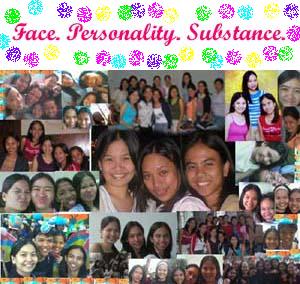|
| My bedroom, My haven
Most of us girls spend a great deal of time in our bedrooms, especially when it comes to relaxing and sleeping after a long day of schoolwork, gimmick, etc. It is also in our rooms where we dress up and even do our make-up. But even if you don’t spend a lot of time in your room, you should still keep it looking nice and pleasing to the eyes. It is a well-known fact that what we see can affect our moods. This applies to most, if not all, people, regardless of gender. We tend to get moody, frustrated, short-tempered and even stress-out if we are constantly seeing and in the middle of clutter and disorganization. So by containing clutter, we will find ourselves a bit more organized and not always exhibiting a negative aura, and eventually turning our bedrooms into one haven with that nurturing atmosphere. After all, our bedrooms should be a serene place that lulls us to sleep and makes us feel relaxed.
No matter how small (or simple) or how big our bedrooms are, what matters is how we organize the things inside them. But how do we do that? Here are the basics of bedroom “de-clutter-ing”:
MATERIALS NEEDED:
- Wet cloth
- Feather duster
- Glass cleaner
- Vacuum cleaner
- Broom (if you do not have a vacuum cleaner)
- Laundry basket
- File cases
- Hooks
- Hangers and rods
- Several storage boxes (depending on the volume of things you have in your room)
- CD rack(s)
- Draping fabric (with your choice of color)
- Bed sheets
- Pillow cases
- Dividers
- Cardboards (which will be made into dividers if you don’t want to buy one)
PROCESSES:
ORGANIZING THE BED
Fluff the pillows, then straighten the bed sheets.
Bed sheets and pillow cases should be cleaned at least every two weeks. But if you realize your sheets and cases are covered with dust and smell awful already, you might wash or change them more often as needed.
If you have a tall enough bed, the space under it is a good place for storage. Use underbed storage boxes or chests to store out-of-season clothes and other miscellaneous items that you have in your room. Storing things in boxes or chests under the bed is a good idea to keep things dust-free.
ORGANIZING THE CLOSET
Begin by sorting. The only clothes in your closet should be the ones that fit, the ones that you like, and those that make you look good. Group your clothes by category: shirts, shorts, blouses, jeans, skirts, slacks, dresses, jackets, etc. Then sort by color, casual of dressy, long-sleeved or short-sleeved. Maintaining this system will tell you at a glance what type or style of clothing you need before you go shopping.
Decide what will be folded, what will be placed on hangers, what will go into drawers, and what will be thrown away or donated.
Use bins and shelf dividers to keep the folded items stacked.
Blouses, jackets, slacks, jeans, and skirts can hang on the rods. Longer items like dresses will need to hang on a higher rod.
If possible, formal dresses and other clothes that are not worn everyday be shifted to another closet. Or place the clothes that you wear most often in the easiest to reach location.
Belts and scarves can be hung on hooks on the door of the closet, on specialty hangers, or rolled and kept in plastic boxes. Label these boxes for quick retrieval.
If there is unused space at the top of your closet(s), place chests for storing off-season clothes of those that you do not wear but have sentimental values.
ORGANIZING THE CHEST OF DRAWERS
Decide what will go in each drawer. For example, you may have a sock drawer, a T-shirt drawer, or a pajama drawer. If this is something new to you, stick labels on the outside of the drawers for quick referral. Rather than have a bit of everything in every drawer, it is better to assign specific items for each drawer. For us girls, it will be very helpful if we have separate drawers for our bras, panties, hankies, and socks (sort them into pairs and fold together).
ORGANIZING THE DRESSER
Clear off all the things on the dresser.
Dust and polish it.
You can squirt a glass cleaner to you cloth and clean the mirror, too.
Sort through the things on the dresser.
Get rid of unused colognes or empty perfume bottles for more space.
Arrange deodorants, perfumes, colognes, lotions, hand creams, cotton bud container, etc. for a more organized look and feel.
Have a separate jewelry box for your earrings, necklaces, bracelets, and wristwatches so you will know exactly where they are and avoid the possibility of misplacing or losing them, compared to you just leaving them on top of the dresser.
ORGANIZING THE ROOM ITSELF
To start off, be sure to carry with you a feather duster and a wet cloth.
Pick up everything on the floor. Try not to have things sitting all over the room. Find the right place that they should belong to.
Basically, the room should be used only for sleeping, relaxing, and dressing. Try not to use the bedroom as a storage room. If you find that you do your work in your room and while lying in bed, make sure that all your books and paperworks will be arranged carefully after using them. Keep books on shelves and the paperworks in different file cases. Label these file cases according to your subjects for easy searching.
Use a feather duster to get rid of the dust as you go along. Make sure to dust picture frames, corners, windowsills, books, shelves, your desktop computer, etc.
Carry a wet cloth with you to wipe away fingerprints and other spots of dirt. A squirt of glass cleaner and a quick wipe will clean all the glass surfaces there are in your room. If you do not have a glass cleaner, water will do the job for it.
A vacuum cleaner can be used to run over carpets (if you have any), the top of closets and drawers, and the spaces under hard-to-move drawers and closets. If your room has hardwood floors and does not have a carpet, a broom may be used as an alternative to the vacuum cleaner.
Even if you have a lot of things, you can do simple things to “hide” them from the eyes. If you use shelves in your room and they get packed with all sorts of things (making them unsightly), over them with a nice piece of draping fabric over the top of the shelves. This will not only hide what is on the shelves, it will also add some color to your room.
Keep the dirty clothes from getting in the way of your bedroom. It only creates clutter. In order to get rid of the pile of clothes in your hallway, place a laundry basket for dirty clothes in one corner of the room.
The CDs should be arranged in a CD rack so they won’t just be scattered anywhere.
TIPS:
Create a cleaning schedule of your own. If you cannot clean your room everyday because of schoolwork overload, allot a day when you can have a general cleaning of your room. But before you reach this “major” cleaning day, make it a habit to grab a small piece of paper and take note (everyday, if possible) of all those big bedroom “projects” that you have to undertake. Stick to your plan and work on each of these projects religiously. If you are cleaning out from under the bed and run across another project, add it to your list for another cleaning day.
The main questions that you have to ask yourself are: “Do I still need this?” and “Does that stuff belong there?” If you see a thing inside you room, ask yourself these two questions. Your answers will determine if that thing will go to the “To Trash” or “To Donate” Box or it will be put in its proper place inside the bedroom.
In order for you to say that “My bedroom is my haven,” you only need to remember a few things: wash and change the bedcovers and pillow cases, dust the room completely, vacuum every crack and corner, clean your ceiling and other light fixtures, wash the curtains, clean the carpet, de-clutter the closet, and rearrange the furniture. Of course, you have to make sure that the cleaning routine you choose works for you. Constantly revise it to fit your ever-changing lifestyle. And if you will just make up your bed each morning and get it into a habit; and when you take something out of each drawer, you put it back in its original space, you will find that there is no reason you cannot have a good sleep everytime you are inside your clutter-free bedroom.
Back to ARTICLES
| |






